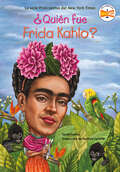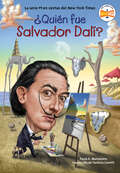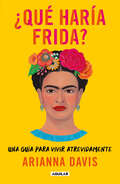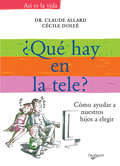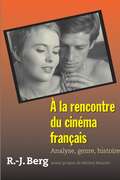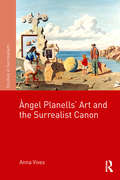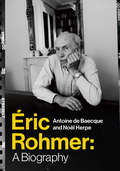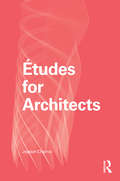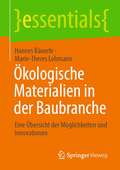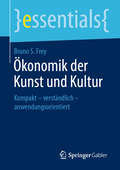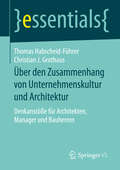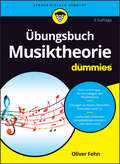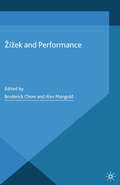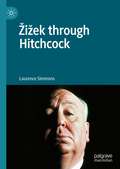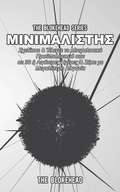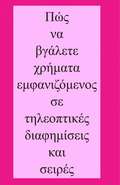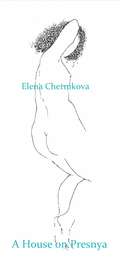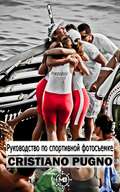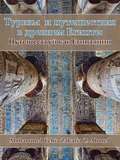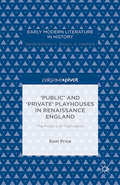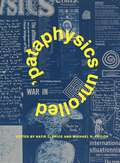- Table View
- List View
¿Quién decide por ti cuando decides tú?
by Domm Cobb Pedro Jara¿Quién lleva el timón de tu vida? La ilustradora Domm Cobb y el psicólogo Pedro Jara te lo cuentan en este libro que inaugura un nuevo género literario: la psicología ilustrada. EN ESTE MUNDO RUIDOSO QUE INSISTE EN DECIRTE LO QUE TIENES QUE SER, TOMA LA DECISIÓN DE SER TÚ Pequeñas o grandes, conscientes o inconscientes, los seres humanos nos pasamos la vida tomando decisiones, pero ¿hasta qué punto decidimos con verdadera libertad y autonomía? ¿De dónde sale aquello que tú, de forma casi automática, consideras «verdad»? Aunque no te des ni cuenta, las voces, discursos, imágenes, mensajes, aprendizajes, tradiciones e inercias que nos rodean y que aprendimos e imitamos constantemente, tienen mucho que ver con los caminos que eliges. Así que, ¿cómo decidir por ti mismo cuando tal vez no sepas quién eres en realidad tú mismo? El psicólogo Pedro Jara y la viñetista y creativa Domm Cobb se unen para crear un libro verdaderamente pionero y original que inaugura un género: la psicología ilustrada. Una combinación de texto y viñetas, seriedad y humor, reflexión e ironía, para ayudarte a ti, lector, a tomar, de manera auténtica y real, las riendas de tu vida. «Somos cerebros emocionales con muchos mecanismos evolutivos desfasados respecto a los retos y modos de vida de hoy en día. La propensión al autoengaño y a la ficción no es solo una característica muy humana, sino que es, de hecho, lo que esencialmente diferencia a los humanos de los demás homínidos, la característica que mejor nos define. Pero ser conscientes de todo ello es un primer gran paso. (...) Cultivar la conciencia y el autoconocimiento es la única medicina posible. No obstante, aplicarla es más complicado de lo que parece, porque también podemos tomar muchas decisiones y acceder a mucha información que nos encamina a una verdadera ilusión ingenua de conciencia y autoconocimiento, es decir, a un falso autoconocimiento. Nuestras distorsiones y limitaciones mentales también actúan cuando nos enfocamos en combatir nuestras distorsiones y limitaciones. ¡No desesperemos! Saber lo poco que sabemos es un primer gran paso y un acto de sabiduría».
¿Quién fue Frida Kahlo? (¿Quién fue?)
by Sarah Fabiny Who HQDescubra más sobre Frida Kahlo, la mujer que pasó a la historia como una de las artistas más emblemáticas del siglo XX. Find out more about Frida Kahlo, the woman who painted herself into history as one of the most iconic female artists of the twentieth century -- now available for Spanish speakers everywhere!Siempre se puede reconocer un cuadro de Kahlo porque ella está en casi todos, con su pelo negro trenzado y sus coloridos trajes mexicanos. Una mujer valiente que estuvo inválida la mayor parte de su vida, se transformó en una obra de arte viva. Tan famosa por sus autorretratos e imágenes inquietantes, así como por su matrimonio con otro famoso artista, Diego Rivera, esta pintora fuerte y valiente se inspiró en la antigua cultura e historia de su amada patria, México. Sus cuadros siguen informando e inspirando a la cultura popular de todo el mundo. You can always recognize a painting by Kahlo because she is in nearly all--with her black braided hair and colorful Mexican outfits. A brave woman who was an invalid most of her life, she transformed herself into a living work of art. As famous for her self-portraits and haunting imagery as she was for her marriage to another famous artist, Diego Rivera, this strong and courageous painter was inspired by the ancient culture and history of her beloved homeland, Mexico. Her paintings continue to inform and inspire popular culture around the world.
¿Quién fue Salvador Dalí? (¿Quién fue?)
by Paula K. Manzanero Who HQLearn about the fascinating career of surrealist Salvador Dalí from his early life in Spain through his public life as an internationally famous artist in this exciting addition to the #1 New York Times Best-Selling series.Conoce la fascinante carrera del surrealista Salvador Dalí, desde sus primeros años en España hasta su vida pública como artista de fama internacional, en este nuevo libro de la serie número uno en ventas del New York Times.Most famous for his surrealist painting The Persistence of Memory and its melting clocks, Salvador Dalí combined his dreamlike ideas with his excellent technical skills to become one of the most famous artists of the twentieth century. Beyond painting, Dalí pursued the arts in many other mediums including sculpture, film, fashion, photography, architecture, and more. He was friends with many of his famous contemporaries, including Picasso, Bunuel, Miro, and Duchamp. Learn about the sometimes-shy man with the instantly recognizable upturned mustache in this book for young readers that details the life of one of modern art's most celebrated figures.Más famoso por su pintura surrealista La persistencia de la memoria y sus relojes derretidos, Salvador Dalí combinó sus ideas oníricas con sus excelentes habilidades técnicas para convertirse en uno de los artistas más famosos del siglo XX. Más allá de la pintura, Dalí se dedicó a las artes en muchos otros medios, como la escultura, el cine, la moda, la fotografía, la arquitectura y más. Era amigo de muchos de sus contemporáneos famosos, incluidos Picasso, Buñuel, Miró y Duchamp. Aprende sobre el hombre a veces tímido, con un bigote reconocible al instante, en este libro para lectores jóvenes que detalla la vida de una de las figuras más célebres del arte moderno.
¿Qué estás mirando? 150 años de arte moderno en un abrir y cerrar de ojos
by Will GompertzAmantes del arte, escépticos y desconcertados: esta historia del arte moderno es para vosotros ¿Qué es el arte moderno? ¿Por qué se ama o se odia? ¿Y por qué es siempre tan exageradamente caro? Will Gompertz, director de Arte de la BBC, exdirector de la Tate Gallery de Londres y uno de los mayores expertos del mundo, ha escrito una deslumbrante guía que cambiará para siempre la manera en que miramos el arte contemporáneo. Desde los nenúfares de Monet hasta los girasoles de Van Gogh, pasando por las latas de sopa de Warhol y los tiburones en formol de Hirst, este libro nos descubre la historia que hay detrás de las obras, las personas que hay detrás de los artistas y la verdadera magia que esconde el arte moderno. Dirigido tanto a escépticos como a convencidos, ¿Qué estás mirando? resuelve todas las preguntas que siempre nos planteamos y nunca nos atrevimos a hacer. En un sorprendente recorrido por los últimos ciento cincuenta años del arte salpicado de reveladoras anécdotas, Gompertz nos explica en qué consiste la genialidad de Pollock o Cézanne, cómo un urinario cambió el curso de la historia o por qué nuestro sobrino de cinco años realmente no lo haría igual. Original, irreverente y muy accesible, este libro rompe con mitos y prejuicios y hará que nuestra próxima visita a un museo sea menos intimidante y mucho más apasionante. La crítica ha dicho:«Will Gompertz [...] un tipo singular. Rápido como la sangre. Y de algún modo un defensor de la claridad en un territorio de opacidades. Entra en faena desde un libro lúcido que tiene algo de síntesis mental de lo complejo. [...] una exploración que desacraliza con audacia e ironía tanto el cuello duro de la crítica de arte, a la vez que hace su propia crítica desde la orilla de la claridad.»Antonio Lucas, El Mundo «Es tan provocador, irreverente, irónico, divertido y políticamente incorrecto como muchos de los artistas de los que habla. Gompertz da un buen repaso (en todos los sentidos) al arte moderno y contemporáneo. Su visión del mundo del arte es inteligente, salpimentada con buenas dosis de humor.»Nati Pulido, ABC «Tanta contundencia en las opiniones proviene de Will Gompertz, director de arte de la BBC y considerado una autoridad mundial en el arte moderno y contemporáneo. [...] En realidad, el libro requiere algo más que un simple pestañeo. Se lee más bien como un completo y ameno manual de 472 páginas.»Ángeles García, El País «Para salvar la brecha que separa a muchos visitantes de los objetos que contemplan, Gompertz ha escrito precisamente ¿Qué estás mirando?, un ameno recorrido por la creación moderna para que la comprenda todo el mundo.»Javier Ors, La Razón «Will Gompertz es de esa estirpe de profesionales que, porque de verdad saben, no necesita demostrar nada. Aúna sencillez, falta de afectacióny hondura, con lo que alimenta en quien le escucha la sensación de que en cada una de sus palabras hay un poso de sabiduría. [...] ¿Qué estás mirando?, un texto original, irreverente y muy accesible que, dirigido tanto a escépticos como a convencidos, resuelve una buena porción de esas preguntas que muchos se plantean y pocos se atreven a formular.»Hoyesarte.com (10,490 Traffic Rank en España, Alexa)
¿Qué haría Frida?: Una guía para vivir atrevidamente
by Arianna DavisA través de las reflexiones sobre esta singular vida, Davis nos invita a invocar la audacia de Frida para guiarnos por nuestros propios caminos. Venerada tanto por su espíritu salvaje, como por su arte, Frida Kahlo es un símbolo de creatividad arriesgada.Durante décadas sus pinturas han permanecido atemporales, cautivando admiradores de distintas generaciones alrededor del mundo. Sin embargo, su más grande obra de arte es quizá su propia vida. ¿Qué haría Frida? celebra el estilo característico de esta icónica mujer, la franqueza de sus ideales, su apasionada vida amorosa y su intrépido arte —incluso frente a las dificultades, el dolor y la angustia—. Sus páginas rinden homenaje a una mujer que amó profundamente y vivió con ambición, negándose a permanecer a la sombra de su esposo, el famoso muralista Diego Rivera. Frida se enfrentó a diversos obstáculos, sin embargo, su tenacidad para abrazar y luchar por sus propias creencias, la llevó a convertirse en leyenda: una figura que bebía mucho, pintaba provocativamente, ejercía con libertad su sexualidad y con todo mundo dejaba correr los rumores de sus relaciones, desde León Trotsky, hasta Josephine Baker. A través de las reflexiones sobre esta singular vida, Davis nos invita a invocar la audacia de Frida para guiarnos por nuestros propios caminos. «Una versión contemporánea de una mujer que fue moderna más allá de su tiempo. El libro de Arianna Davis pinta una imagen colorida de la fuerza, el coraje y el amor que animaron a Frida Kahlo a través de sus tragedias. Esta mirada completa a su vida me lleva a pensar que todos podrían aprender una lección o dos de Frida.» —Nina García, editora en jefe de Elle «Una lectura obligada. Este es un retrato sincero de una mujer brillante y compleja cuya audaz perspectiva sobre la creatividad, el trabajo y el sexo resiste la prueba deltiempo.» —Jessica Knoll, autora bestseller deThe New York Times de La chica que lo tenía todo «Arianna Davis presenta un hermoso testimonio para que las mujeres contemporáneas sigamos los pasos de Frida mientras navegamos por el amor, el trabajo, la creatividad, la amistad e incluso cómo nos vestimos por la mañana. Este vibrante libro de historia y autoayuda es un regalo.» —Gabrielle Korn, directora de moda y cultura en Refinery29 «Frida Kahlo verdaderamente hizo de su confianza, su autoaceptación y su intrepidez, una forma de arte. Este libro nos recuerda de una manera hermosa qué abundante puede ser la fuerza de una mujer.» —Julissa Prado, fundadora y CEO de Rizos Curls
¿Qué ponen en la tele?
by Claude Allard Cécile DolléLa televisión alimenta las discusiones familiares. Por un lado, están los padres, que a menudo consideran que los niños la miran demasiado, incluso cuando ellos también están enganchados a la pequeña pantalla. Por el otro, están los hijos, fascinados por la cantidad de imágenes, remedio fácil contra el aburrimiento. Este libro intenta desembrollar los miedos de los padres, fundados o excesivos, y ofrece pistas para mirar la televisión de forma inteligente, ya que ésta se ha convertido en una distracción familiar ineludible. Por ello, esta obra trata de dar respuesta a cuestiones tales como: * ¿Qué miran realmente los niños? * ¿Qué valores transmite la televisión? * ¿Cómo elegir juntos un programa? * ¿Podemos juzgar sin conocer? * ¿Por qué hay que establecer límites de tiempo? * ¿Cómo arreglar los desperfectos si el niño ha visto una escena violenta? * ¿Cómo desenganchar a alguien de la televisión? El doctor Claude Allard es psiquiatra y psicoanalista, y autor de obras enfocadas a la influencia de la televisión en nuestra vida. Cécile Dollé es periodista.
À la rencontre du cinéma français: Analyse, genre, histoire
by R. J. BergÀ la rencontre du cinéma français: analyse, genre, histoire is intended to serve as the core textbook in a wide variety of upper-level undergraduate and graduate French cinema courses. In contrast to content-, theme-, or issue-based approaches to film, Professor Berg stresses “the cinematically specific, the warp and fabric of the film itself, the stuff of which it is made.” Sufficient proficiency in French is the sole prerequisite: “No previous background in film studies is assumed, nor is any prior acquaintance with French cinema. It will help, of course, to like movies, and to have seen quite a few…” (from the preface).
Àngel Planells’ Art and the Surrealist Canon (Studies in Surrealism)
by Anna VivesHaving been mistakenly perceived as a follower of Salvador Dalí, Catalan surrealist painter and writer Àngel Planells (1901–1989) has passed through the history of art practically unnoticed. Yet his work suggests an influence on a number of works by Dalí, proving that a fairer way to define their relationship is as an artistic dialogue. His participation in the groundbreaking International Surrealist Exhibition in London in 1936 is in itself a marker of his quality as an artist, but Planells’ contribution to surrealism is remarkable for his use of astronomy, fantastic scenes redolent of Edgar Allan Poe’s narrative as well as ludic elements and meta-pictorial techniques that contest Fascism.
Éric Rohmer: A Biography
by Steven Rendall Lisa Neal Antoine De Baecque Noël HerpeThe director of twenty-five films, including My Night at Maud's (1969), which was nominated for a Best Picture Academy Award, and the editor in chief of Cahiers du cinéma from 1957 to 1963, Éric Rohmer set the terms by which people watched, made, and thought about cinema for decades. Such brilliance does not develop in a vacuum, and Rohmer cultivated a fascinating network of friends, colleagues, and industry contacts that kept his outlook sharp and propelled his work forward. Despite his privacy, he cared deeply about politics, religion, culture, and fostering a public appreciation of the medium he loved.This exhaustive biography uses personal archives and interviews to enrich our knowledge of Rohmer's public achievements and lesser known interests and relations. The filmmaker kept in close communication with his contemporaries and competitors: François Truffaut, Jean-Luc Godard, Claude Chabrol, and Jacques Rivette. He held a paradoxical fascination with royalist politics, the fate of the environment, Catholicism, classical music, and the French nightclub scene, and his films were regularly featured at New York and Los Angeles film festivals. Despite an austere approach to life, Rohmer had a voracious appetite for art, culture, and intellectual debate captured vividly in this definitive volume.
Éric Rohmer: A Biography
by Noël Herpe Antoine de BaecqueThe director of twenty-five films, including My Night at Maud's (1969), which was nominated for a Best Picture Academy Award, and the editor in chief of Cahiers du cinéma from 1957 to 1963, Éric Rohmer set the terms by which people watched, made, and thought about cinema for decades. Such brilliance does not develop in a vacuum, and Rohmer cultivated a fascinating network of friends, colleagues, and industry contacts that kept his outlook sharp and propelled his work forward. Despite his privacy, he cared deeply about politics, religion, culture, and fostering a public appreciation of the medium he loved.This exhaustive biography uses personal archives and interviews to enrich our knowledge of Rohmer's public achievements and lesser known interests and relations. The filmmaker kept in close communication with his contemporaries and competitors: François Truffaut, Jean-Luc Godard, Claude Chabrol, and Jacques Rivette. He held a paradoxical fascination with royalist politics, the fate of the environment, Catholicism, classical music, and the French nightclub scene, and his films were regularly featured at New York and Los Angeles film festivals. Despite an austere approach to life, Rohmer had a voracious appetite for art, culture, and intellectual debate captured vividly in this definitive volume.
Études for Architects
by Joseph ChomaOrganized around a series of pedagogical exercises, this book provides a visual journey through a series of games architects can play as a means to design. Aimed specifically at beginner design students, learning objectives include: computational thinking and making, introduction to design as an iterative, reflective, and rigorous process, ideas of continuity and discontinuity, and understanding the bias and constraints of analog and digital tooling. The text is simple and straightforward to understand and in addition the author draws explanatory diagrams to elaborate on each exercise's description. He also includes visually compelling student work to provide insight into the possibilities of each exercise. Finally, the book includes eighteen case studies from Europe, the USA, Mexico, and Asia to inspire and inform.
Ökologische Materialien in der Baubranche: Eine Übersicht der Möglichkeiten und Innovationen (essentials)
by Hannes Bäuerle Marie-Theres LohmannDieses essential zeigt wirksame und innovative Materialbeispiele, die maßgeblich für ein besseres Raumklima eigesetzt werden können und erklärt gleichzeitig, warum ein Umdenken in Richtung Nachhaltigkeit in der Baubranche wichtig ist. Einleitend gibt es einen kurzen Einblick in die Thematik rund um Ökologie und Nachhaltigkeit. Beispielhafte Materialien unterschiedlicher Bereiche und Möglichkeiten der Entsorgung werden aufgeführt. Zudem wird eine denkbare Zukunft im Baubereich fokussiert. Somit bietet das essential einen informativen Rundumblick in die Welt des nachhaltigen Bauens.
Ökonomik der Kunst und Kultur: Kompakt – verständlich – anwendungsorientiert (essentials)
by Bruno S. FreyBruno S. Frey untersucht Kunst und Kultur vom Standpunkt der Wirtschaftswissenschaften – vor allem unter zwei Aspekten: der Beziehung zwischen Kunst und Wirtschaft sowie der Anwendung ökonomischen Denkens auf den Bereich der Kunst und Kultur. Wichtige Bereiche der Kunstökonomik befassen sich mit der darstellenden und bildenden Kunst, Museen, der Kulturindustrie, dem Kulturtourismus und dem kulturellen Erbe. Mit der Anwendung ökonomischen Denkens wird eine neue Art der Interdisziplinarität eröffnet. Die Kunstökonomik ist eine spannende Anwendung der ökonomischen Denkweise. Finanzwissenschaftliche Aspekte stehen dabei im Vordergrund. Der Autor erörtert Möglichkeiten, welche Rolle der Staat in der Finanzierung der Kunst spielt und spielen kann.Der Autor: Bruno S. Frey ist Ständiger Gastprofessor an der Universität Basel und Forschungsdirektor bei CREMA – Center for Research in Economics, Management and the Arts, Zürich/Schweiz. Zuvor war er Professor an den Universitäten Konstanz, Zürich, Chicago, Warwick und Friedrichshafen und ist mit fünf Ehrendoktoraten in fünf Ländern ausgezeichnet worden.
Über den Zusammenhang von Unternehmenskultur und Architektur: Denkanstöße für Architekten, Manager und Bauherren (essentials)
by Thomas Habscheid-Führer Christian J. GrothausDie Autoren bieten in diesem essential eine kleine Reise durch die Ideen der Architekturgeschichte, die hinter der klassischen Moderne, der Postmoderne und dem architektonischen Strukturalismus stecken. Sie führen Soziologie, Architektur und Organisationstheorie zusammen mit dem Ziel, die Prämissen von Gebäuden zu erläutern, die Wissen vermehren. Die Autoren plädieren dafür, im Gebäude eine „situative Identität“ zu stiften. Dieses Konzept führt die herkömmliche, markenfixierte „Corporate Architecture“ weiter und beschreibt eine Gebäude-Performanz, die der Mitarbeiterschaft ein kooperatives und vernetztes Arbeiten erleichtert – aber nicht verordnet von oben nach unten, sondern umgekehrt. Eine lebendige und individuelle Unternehmensarchitektur zeigt sich nur, wenn sie gleichermaßen in Organisationsprozessen wie räumlichen Ausprägungen virulent ist.
Übungsbuch Musiktheorie für Dummies (Für Dummies)
by Oliver FehnWenn der Stoff sitzen soll, muss man die Theorie auch mal praktisch angehen. Denn auch bei der Musiktheorie hilft vor allem Üben, Üben, Üben. Dieses Buch enthält abwechslungsreiche Übungen, kurzweilige Multiple-Choice-Tests, hilfreiche Eselsbrücken und viele Tipps und Tricks, die Ihnen helfen, Ihr musiktheoretisches Wissen zur Perfektion zu bringen. Sie finden kompakte Erklärungen der wichtigsten musiktheoretischen Grundlagen und natürlich ausführliche Lösungen zu den zahlreichen Übungen. Viele der Übungen und Lösungen gibt es außerdem zum Anhören als Download. Sie erfahren Wie Sie Ihr musiktheoretisches Wissen durch Übungen zu Noten, Akkorden, Intervallen, Tonleitern, Tonarten und Co. vertiefen Wie Sie Musik notieren und spielen Wie Sie Ihr Lieblingsstück in eine andere Tonart transponieren
Žižek and Performance (Performance Philosophy)
by Broderick Chow Alex MangoldThe first edited volume to examine philosopher Slavoj Žižek's influence on, and his relevance for, theatre and performance studies. Featuring a brand new essay from Žižek himself, this is an indispensable contribution to the emerging field of Performance Philosophy.
Žižek through Hitchcock
by Laurence SimmonsMaverick Slovenian cultural theorist, philosopher and psychoanalyst Slavoj Žižek has made his name elaborating the complexities of psychoanalytic and Marxist theory through the exotic use of examples from film and popular culture. But what if we were to take Žižek’s pretensions to cinephilia and film criticism seriously? In this book, adopting Žižek’s own tactic of counterintuitive observation, we shall read the corpus of Alfred Hitchcock’s films (‘one of the great achievements of Western civilization’) and Žižek’s idiosyncratic citation of them in order to arrive at a position where we can identify the core commitments that inform Žižek’s own work. From the practice of Hitchcock we shall (hopefully) arrive at a theory of Žižek (just as Žižek in his collection Everything You Always Wanted to Know About Lacan (But Were Afraid to Ask Hitchcock) (Verso, 1992) arrives at a theory of Lacan from the practice of Hitchcock). To achieve this goal each chapter looks at a specific film by Hitchcock and explores a specific key concept crucial to the elaboration and core of Žižek’s ideas.
Μινιμαλιστής: Σχεδίασε & Έλεγξε το Μινιμαλιστικό Προϋπολογισμό & Ζήσε με Μεγαλύτερη Αθφονία
by Ελένη ΠέποναΣε αυτό το εγχειρίδιο ο συγγραφέας εισάγει τον αναγνώστη στην ιστορία και τις αρχές του μινιμαλισμού ως τρόπου ζωής. Συζητά τις βασικές αρχές του μινιμαλισμού και δίνει πρακτικές συμβουλές και παραδείγματα για την εφαρμογή του. Παράλληλα, διαπραγματεύεται την ανάγκη που διακατέχει τις μοντέρνες κοινωνίες για την απόκτηση πολλαπλών υλικών αγαθών, πώς ο μινιμαλισμός μπορεί να προσφέρει μια έξοδο από τον εγκλωβισμό στην υπερκατανάλωση, και τέλος παρουσιάζει μία μέθοδο σχεδίασης μηνιαίου προϋπολογισμού που μπορεί να βοηθήσει τον αναγνώστη να επιτύχει τους μακροπρόθεσμους και βραχυπρόθεσμους στόχους του με τη βοήθεια του μινιμαλισμού.
Πώς να βγάλετε χρήματα εμφανιζόμενος σε τηλεοπτικές διαφημίσεις και σειρές (Levine's Guide To Knives And Their Values Ser.)
by Bernard Levine Δήμητρα ΣτασινούΕίχατε ποτέ την επιθυμία να εργαστείτε σε τηλεοπτικές διαφημίσεις; ... όπως οι διαφημίσεις κινητών των εταιρειών Nokia ή Samsung καθώς και σε διαφημίσεις των McDonald's ή Coca Cola; Θα θέλατε να συμμετέχετε σε τηλεποτική σαπουνόπερα ή σειρά; Δε χρειάζεται εμπειρία. Τώρα είναι η ευκαιρία σας να κάνετε το όνειρό σας πραγματικότητα. Έχει πολλή πλάκα και τα χρήματα που θα βγάλετε θα αξίζουν τον κόπο!
А House on Presnya
by Nina Šoltić Elena ChernikovaFive autobiographical stories and a novel-allusion about love and posthumous life; written by a woman, in Russia, about the domestic male material.
Руководство По Спортивной Фотосъемке
by Вероника Иванова Cristiano PugnoРуководство для тех, кто впервые решил заняться спортивной фотосъёмкой. Содержит практические советы по некоторым наиболее распространённым видам спорта.
Туризм и путешествия в древнем Египте: Travel Like An Egyptian
by Mohammed Yehia Z. AhmedЭта книга исследует путешествия в древнем Египте. В ней анализируются средства передвижения, дороги, еда, питье и проживания для поездок. Она также сравнивает путешествия в древнеегипетские времена и сегодня и обсуждает, были ли древние Египтяне туристами или нет.
كتاب الموسيقى الشرقي
by محمد كامل الخلعيالموسيقى هو علم يبحث فيه عن أحوال النغم من جهة تأليفه اللذيذ والنافر ـ وعن أحوال الأزمة المتخللة بين النغمات من جهة الطول والقصر. فعلم أنه يتم بجزئين: الأول علم التأليف وهو اللحن ـ والثاني علم الإيقاع وهو المسمى أيضًا بالأصول. (فالنغمات) جمع نغمة بالتحريك وهي (لغة) الصوت الساذج الخالي من الحروف ـ و(اصطلاحًا) الصوت المترنم به. (واللحن) بالسكون (لغة) صوت من الأصوات المصوغة و(اصطلاحًا) ما ركب من نغمات بعضها يعلو أو يسفل عن بعض على نسب معلومة ـ (والنغم للحن كالأحرف للكلام)ـ ثم يرتب ترتيبًا موزونًا ـ أي أنه يصاغ على أحد الأوزان التي سنذكرها بعد. ويقرن بشيء من الشعر أو غيره من سائر الفنون السبعة التي هي ـ القريض ـ والدويت ـ والموالي ـ والموشح ـ والزجل ـ والقومة ـ وكان وكان. وهذا التعريف جامع مانع؛
‘Public’ and ‘Private’ Playhouses in Renaissance England: The Politics of Publication (Early Modern Literature in History)
by Eoin PriceAt the start of the seventeenth century a distinction emerged between 'public', outdoor, amphitheatre playhouses and 'private', indoor, hall venues. This book is the first sustained attempt to ask: why? Theatre historians have long acknowledged these terms, but have failed to attest to their variety and complexity. Assessing a range of evidence, from the start of the Elizabethan period to the beginning of the Restoration, the book overturns received scholarly wisdom to reach new insights into the politics of theatre culture and playbook publication. Standard accounts of the 'public' and 'private' theatres have either ignored the terms, or offered insubstantial explanations for their use. This book opens up the rich range of meanings made available by these vitally important terms and offers a fresh perspective on the way dramatists, theatre owners, booksellers, and legislators, conceived the playhouses of Renaissance London.
’Pataphysics Unrolled (Refiguring Modernism #36)
by Katie L. Price and Michael R. TaylorIn the 1890s, French poet and playwright Alfred Jarry founded pataphysics, the absurdist "science of imaginary solutions," a concept that has been nominally recognized as the precursor to Dadaism, Surrealism, and the Theater of the Absurd, among other movements. Over a century after Jarry "made the gesture of dying," Katie L. Price and Michael R. Taylor argue that it is time to take the comedic intervention of pataphysics seriously.’Pataphysics Unrolled collects critical and creative essays to create an unauthorized account of pataphysical experimentation from its origins in the late nineteenth century through the contemporary moment. Reaching beyond the geographic and cultural boundaries normally associated with pataphysics, this volume presents rich readings of pataphysical syzygy, traces the influence of pataphysics across disciplines and outside of coteries such as the Collège de ’Pataphysique, and asks fundamental questions about the field of modern and contemporary studies that challenge distinctions between the modern and the postmodern, high and low culture, the serious and the comic. Touching on disciplines such as literature, art, architecture, education, music, and technology, this book reveals how pataphysics has been a platform and medium for persistent intellectual, poetic, conceptual, and artistic experimentation for over a century.In addition to the editors, the contributors to this volume include Charles Bernstein, Marc Décimo, Adam Dickinson, Johanna Drucker, Craig Dworkin, Catherine Hansen, James Hendler, John Heon, Ted Hiebert, Andrew Hugill, Steve McCaffery, Seth McDowell, Jerome McGann, Anne M. Mulhall, Marcus O’Dair, Jean-Michel Rabaté, Orchid Tierney, and Brandon Walsh.

